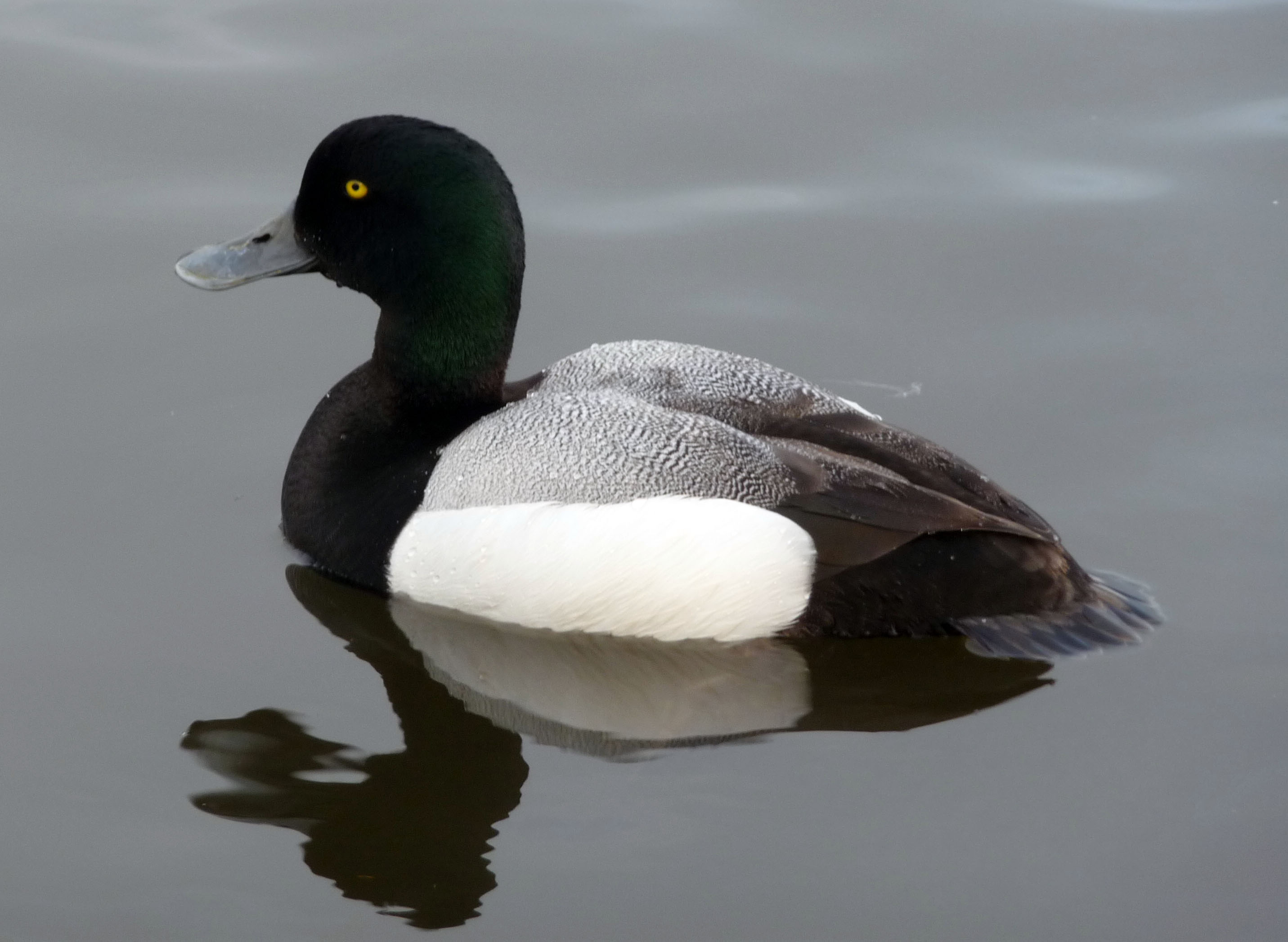
Greater scaup(Aythya marila)
Phylum —chordata
Class — aves
Order — anseriformes
Family — anatidae
Genus –aythya
Appearance
The adult greater scaup is 39–56 cm (15–22 in) long with a 71–84 cm (28–33 in) wingspan and a body mass of 726–1,360 g (1.601–2.998 lb).
It has a blue bill and yellow eyes. The male has a dark head with a green sheen, a black breast, a light back, a black tail, and a white underside. The drake or male greater scaup is larger and has a more rounded head than the female. The drake's belly and flanks are a bright white. Its neck, breast, and tail feathers are a glossy black, while its lower flanks are vermiculated gray. The upper wing has a white stripe starting as the speculum and extending along the flight feathers to the wingtip. Legs and feet of both sexes are gray. The adult female has a brown body and head, with white wing markings similar to those of the male but slightly duller. Juvenile greater scaup look similar to adult females. The greater scaup drake's eclipse plumage looks similar to its breeding plumage, except the pale parts of the plumage are a buffy gray.
Habitat
The greater scaup has a circumpolar distribution, breeding within the Arctic Circle both in the Old World (the Palearctic) and in North America (the Nearctic). It spends the summer months in Alaska, Siberia, and the northern parts of Europe. It is also found in Asia and is present in the Aleutian Islands year round. The summer habitat is marshy lowland tundra and islands in fresh water lakes. In the fall, greater scaup populations start their migration south for the winter. They winter along the Pacific and Atlantic coasts of North America, the coasts of northwest Europe, the Caspian Sea, the Black Sea, the coast of Japan, Yellow Sea and East China Sea. During the winter months, they are found in coastal bays, estuaries, and sometimes inland lakes, such as the lakes of Central Europe and the Great Lakes.
Behavior
During migration and winter, greater scaups form large flocks on bays, lakes, and larger wetlands. They tend to form tight groups with each other and sometimes mix with other diving ducks.
Diet
The greater scaups dive to obtain food, which they eat on the surface. They mainly eat mollusks, aquatic plants, and aquatic insects. During the summer months, the greater scaup will eat small aquatic crustaceans.
Reproduction
Greater scaup begin breeding when they are two years old, although they may start nesting at age one. Drake greater scaup have a soft, quick whistle they use to attract the attention of hens during courtship, which takes place from late winter to early spring, on the way back to their northern breeding grounds. The courtship is complex and results in the formation of monogamous pairs. Pairs nest in close proximity to each other in large colonies, usually near water, on an island or shoreline, or on a raft of floating vegetation. The nest consists of a shallow depression made by the female and lined with her down. After the female lays the eggs, the drake abandons the female and goes with other drakes to a large, isolated lake to molt. These lakes can be close to the breeding grounds or miles away. The lakes chosen are used yearly by the same ducks. The optimal molting lake is fairly shallow and has an abundance of food sources and cover.
The female lays six to nine olive-buff-colored eggs, which she incubates for 24–28 days. A larger clutch could indicate brood parasitism by other greater scaups or even ducks of other species. Newly hatched chicks are covered with down and are soon able to walk, swim, and feed themselves; however, they are not able to fly until 40–45 days after hatching. The vulnerable small chicks follow their mother, who protects them from predators.
In captivity
In captivity, these birds can live up to 20 years, in nature, the lifeexpectancyis much less.
These birds need a deep pool, but the best option is a reservoir (pond).
The diet of these birds should include various kinds of leaves, water lilies, wild celery, wild rice, millet. It should also containmollusks, snails, nymphs, earthworms and leeches. Protein-rich food is important for birds during the reproduction season. During feeding, adult females eat almost only organic food.
 Russian
Russian
 English
English
























